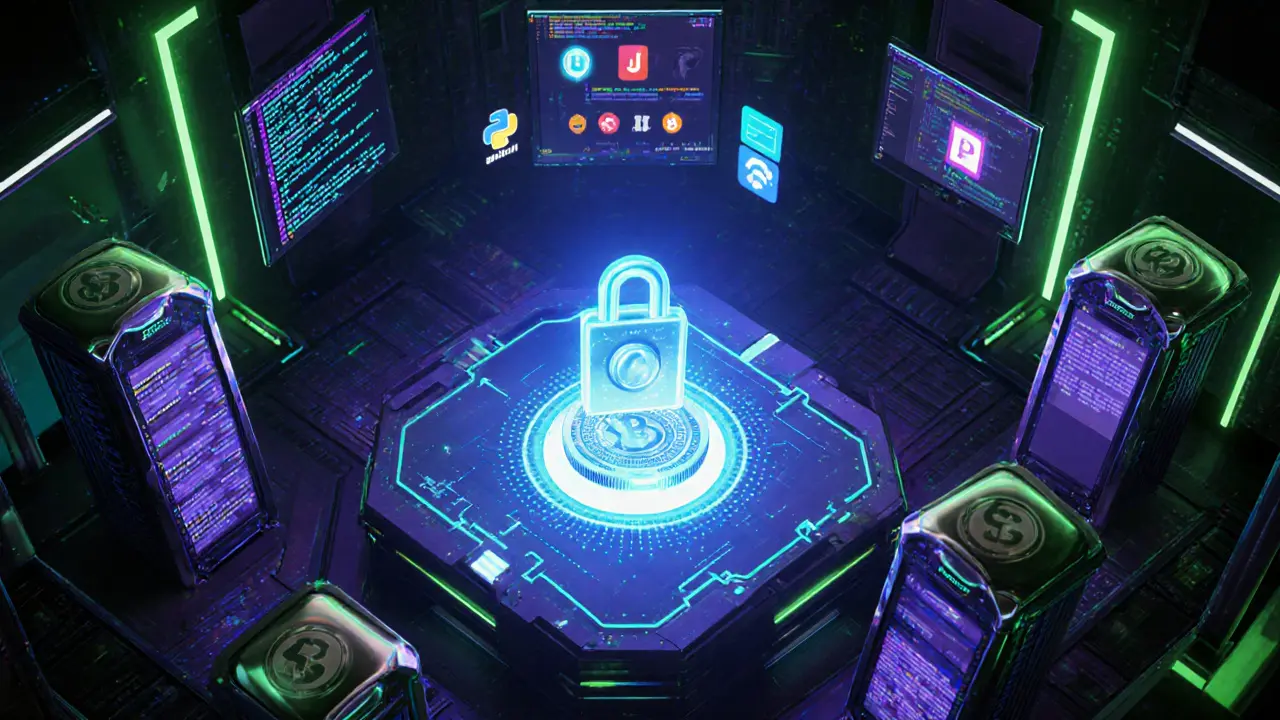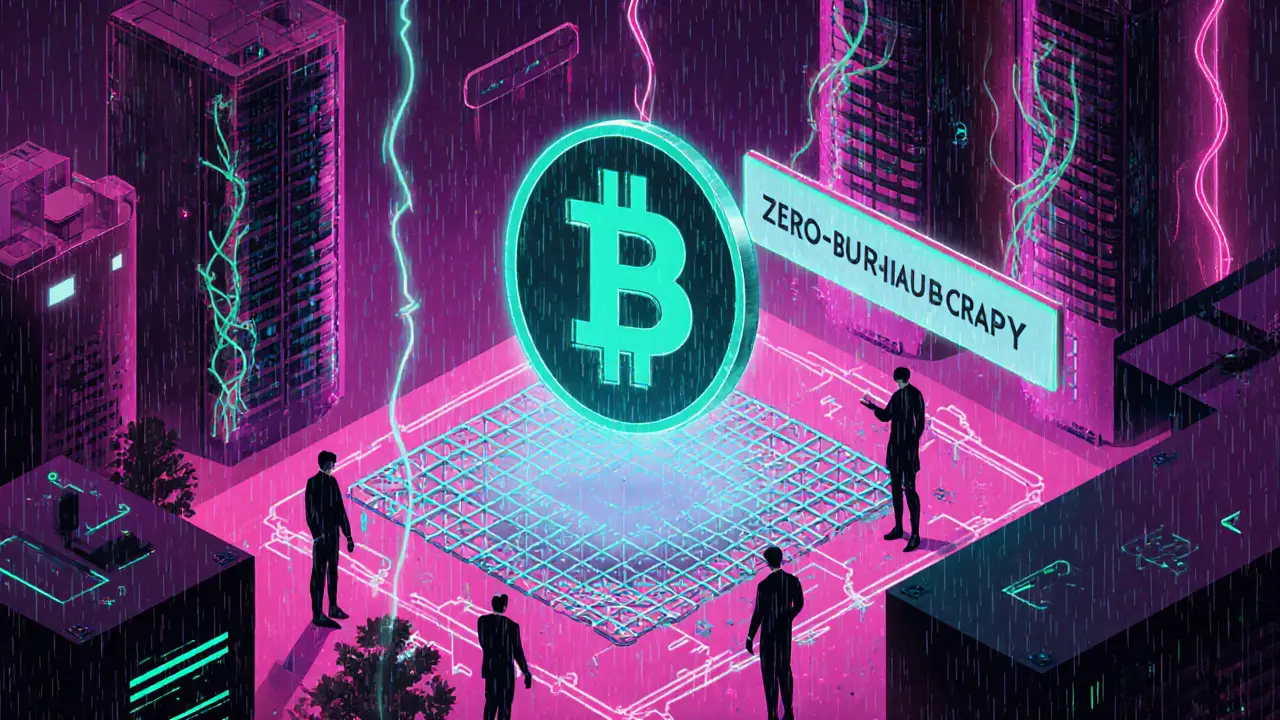COMAI Token Value Calculator
Current Market Data
Based on CoinGecko data as of October 2025
Maximum token supply
Currently in circulation
Estimated based on current price
Projection Results
Key Takeaways
- Commune AI is a community‑driven, open‑source protocol that lets developers access AI services through a crypto‑economic layer.
- The COMAI token acts as validator stake, controlling who can earn rewards for providing AI compute.
- Supply is capped at 1billion tokens; circulating supply is roughly 83million, giving a market cap under $1million.
- Trading happens only on decentralized exchanges like Uniswap v3 and MXC, with very low liquidity.
- Compared with peers such as Bittensor, COMAI has a radical “zero‑bureaucracy” model but also faces steep adoption and liquidity challenges.
What is Commune AI (COMAI)?
When you hear the name Commune AI is a decentralized, peer‑to‑peer protocol that enables the creation and consumption of machine‑learning services without a controlling corporate entity. It was founded by Sal Vivona, a physicist‑turned ML engineer who left big‑tech in 2021 to focus on this vision.
The project describes itself as “cypherpunk at heart, wild and fully organic”. There is no formal foundation, no venture‑capital fund, and no CEO-only code and contributors. The idea is to let anyone stake the native token, become a validator, and earn rewards for running AI workloads that other participants request.
How does the COMAI token work?
The COMAI token serves as Validator Stake. Stakers lock their tokens in a smart contract; the amount locked determines how many AI‑compute jobs they can compete for. When a validator successfully fulfills a request, they receive newly minted COMAI plus a portion of the requestor’s payment, which is also paid in COMAI.
This creates a crypto‑economic incentive loop: more stake → higher chance of earning rewards → more stake. Because the protocol only records the economic outcome (who earned what) on‑chain, the heavy AI calculations happen off‑chain, reducing blockchain bloat and keeping transaction fees low.

Technical design and blockchain architecture
Commune AI runs on a custom, permissionless blockchain that stores only proof of work and payment data. The off‑chain AI validation layer uses a peer‑review system where multiple validators check the integrity of the result before it is recorded. This separation mirrors the approach of projects like Bittensor, but Commune AI emphasizes a modular, plug‑and‑play design that aims to connect any development tool into a single network.
Key technical attributes:
- Maximum token supply: 1,000,000,000 COMAI.
- Consensus: Proof‑of‑Stake with validator reputation scores.
- Off‑chain compute: AI jobs run on volunteer hardware, results are hashed and submitted for on‑chain verification.
- Modular SDKs: Open‑source libraries in Python, Rust, and JavaScript for easy integration.
All code is hosted publicly on GitHub (the repo is linked from the official site) and contributions are tracked via conventional pull‑request workflows.
Market data and price overview (as of October2025)
Price information varies across aggregators, but the consensus range sits around $0.006USD per COMAI. Here’s a snapshot:
- CoinMarketCap: $0.005607, 24‑h volume $326.
- TradingView: $0.006502, up 0.82% in the last day.
- CoinGecko circulating supply: ~83million tokens → market cap ≈ $680k.
Trading is limited to two decentralized exchanges: Uniswap v3 and MXC. The COMAI/USDT pair accounts for virtually all volume, roughly $60k per week, indicating thin order books and high price slippage for large trades.
How Commune AI stacks up against other AI‑focused blockchains
| Project | Max Supply | Current Price (USD) | Market Cap | Primary Exchanges | Governance Model |
|---|---|---|---|---|---|
| Commune AI (COMAI) | 1B | ≈0.006 | ≈$0.68M | Uniswap v3, MXC | Zero‑bureaucracy, community‑only |
| Bittensor (TAO) | 1B | $0.12 | $1.1B | Binance, KuCoin | Foundation‑backed, DAO governance |
| Render Token (RNDR) | 5.5B | $0.57 | $1.3B | Coinbase, Kraken | Corporate + DAO hybrid |
| AIOZ Network (AIOZ) | 21B | $0.04 | $0.8B | Binance, Gate.io | Corporate with community input |
The table shows that COMAI is orders of magnitude smaller in market value and liquidity. Its unique selling point is the “no‑founders, no‑VC” ethos, which may attract purist cypherpunks but also limits the resources available for marketing, developer outreach, and regulatory compliance.

Risks and criticism
Several red flags appear in the data:
- Liquidity crunch: With only two DEX listings and a daily volume under $1k on major aggregators, moving more than a few hundred dollars can cause severe price impact.
- Adoption uncertainty: There are no publicly verified use‑cases or enterprise partnerships. The GitHub repo shows modest activity, suggesting a small developer base.
- Regulatory exposure: As AI‑related tokens attract scrutiny, future rules on data privacy or algorithmic transparency could affect the protocol’s legality.
- Price volatility: Forecasts from CoinLore swing wildly-from $0.19 in 2027 to $24.90 in 2041-highlighting the speculative nature of the asset.
Investors should treat COMAI as a high‑risk, speculative token unless they plan to actively contribute to the network.
How to buy and store COMAI
If you decide to dip your toe in, follow these steps:
- Set up a non‑custodial wallet that supports ERC‑20 tokens (e.g., MetaMask or Trust Wallet).
- Obtain some USDT or ETH on a centralized exchange and transfer it to your wallet.
- Go to Uniswap v3, paste the COMAI contract address (0x… from the official site), and swap your USDT/ETH for COMAI.
- Optionally, add COMAI as a custom token in your wallet to see the balance.
- Stake your tokens via the official staking portal (requires connecting your wallet) if you want to become a validator.
Remember to double‑check the contract address to avoid scams; the official Discord channel posts the correct address daily.
Community and ecosystem
Community interaction lives mainly on Discord. The server hosts channels for development, staking, and general discussion. Because there is no formal support desk, most help comes from volunteer developers. The ecosystem currently offers a few SDKs, a basic UI for staking, and a simple REST API for submitting AI jobs. No major DApps or marketplaces have launched yet.
For developers curious about contributing, the recommended path is:
- Fork the GitHub repo.
- Read the “Contributing” guide, which outlines code style and testing requirements.
- Submit a pull request; if accepted, you earn reputation points that can be later converted to validator stake.
Frequently Asked Questions
What problem does Commune AI aim to solve?
It tries to create a truly decentralized marketplace where anyone can buy or sell AI compute without a central company controlling pricing or access.
How is COMAI different from Bittensor?
Bittensor has a formal foundation and a hybrid DAO, while Commune AI operates with no legal entity, no venture funding, and a strict “code‑only” governance model.
Can I earn passive income by staking COMAI?
Yes. By locking COMAI in the staking contract you become eligible to earn newly minted tokens when your node validates AI jobs.
Is COMAI a good long‑term investment?
It’s highly speculative. The token’s price could explode if developer adoption rises, but low liquidity and minimal real‑world use make it risky for most investors.
Where can I find the official COMAI contract address?
The address is posted on the official Commune AI website and pinned in the Discord announcements channel.


Philip Smart
October 11, 2025 AT 08:34Commune AI looks like another hype project with zero liquidity.
Jacob Moore
October 12, 2025 AT 05:36If you’re looking to actually use COMAI, the first step is to set up a wallet that supports ERC‑20 tokens, like MetaMask. Once you have some ETH or USDT, you can hop onto Uniswap v3 and swap for COMAI using the contract address posted on the official Discord. After the swap, add COMAI as a custom token so you can see your balance. Staking is optional but it’s the main way to earn rewards – just connect your wallet on the staking portal and lock the amount you’re comfortable with. Remember to double‑check the contract address, scammers love to copy‑paste similar strings.
gayle Smith
October 13, 2025 AT 02:38The tokenomics architecture leverages a validator‑stake paradigm that essentially quantizes compute‑capacity into on‑chain credit. By locking COMAI, validators gain proportional access to AI job queues, which then generate emission tokens as fees. This design imitates a decentralized cloud compute marketplace, yet the real‑world demand curve remains virtually flat. The scarcity of listed pairs – only Uniswap v3 and MXC – further compresses price discovery. Moreover, the Github activity hints at a modest developer base, which may throttle protocol upgrades. In short, the hype is backed by an intriguing model but suffers from a classic chicken‑and‑egg liquidity problem.
mark noopa
October 13, 2025 AT 23:40What we see in the COMAI ecosystem is a micro‑cosm of the broader debate about decentralization versus practicality. The protocol claims to eliminate any corporate governance layer, yet it still relies on a handful of core developers to maintain the repo. This paradox creates a tension between ideological purity and the need for sustainable development resources. On the technical side, the off‑chain compute model reduces on‑chain bloat but introduces trust assumptions about validator honesty. Validators are incentivized only by newly minted tokens, which can lead to inflationary pressure if the network scales without a proportional increase in demand. The capped supply of one billion tokens sounds modest, but with only ~83 million circulating, price discovery is extremely fragile. Thin order books on Uniswap v3 and MXC mean that even modest trades cause significant slippage, effectively penalizing liquidity providers. From a security perspective, the lack of a formal audit trail for the off‑chain computation layer leaves open vectors for sabotage or data poisoning. Community governance is pitched as “zero‑bureaucracy”, yet decision‑making still happens in Discord channels that can be dominated by a vocal minority. This raises the question of whether power is truly distributed or simply hidden behind informal social hierarchies. For developers, the open‑source SDKs in Python, Rust, and JavaScript lower the entry barrier, but the scarcity of real‑world integrations limits practical testing. Potential users must also contend with regulatory uncertainty around AI‑related tokens, which could attract future compliance demands. In short, the project sits at the intersection of high‑risk speculation and pioneering blockchain‑AI synergy. Investors seeking passive income might earn staking rewards, but those rewards are contingent on a steady flow of AI jobs that currently seems nascent. Ultimately, whether COMAI becomes a functional layer of decentralized AI or remains a curiosity will depend on community adoption and the ability to attract genuine compute providers.
Rama Julianto
October 14, 2025 AT 20:42Liquidity is the single Achilles’ heel of COMAI, and you can see it in the daily volume numbers. Even a $500 swap will move the price by several percent, making it impossible to execute meaningful trades without massive slippage. This isn’t just an inconvenience; it’s a systemic risk that can wipe out staking rewards overnight. Anyone thinking about putting real money in should treat it as a speculative experiment, not a reliable investment.
Helen Fitzgerald
October 15, 2025 AT 17:44Nice rundown, Jacob! Adding to that, if you’re new to staking, start with a small amount – maybe 100 COMAI – to see how the reward cycle works. The UI can be a bit glitchy, but the underlying contract is solid. Also, keep an eye on the Discord announcements for any upcoming validator incentives; they occasionally run bonus programs.
Jon Asher
October 16, 2025 AT 14:46Got it, the jargon is heavy but the core idea is simple: you lock tokens, you get a chance to run AI jobs, and you earn more tokens.
Jade Hibbert
October 17, 2025 AT 11:49Oh great, another token promising the world.
Leynda Jeane Erwin
October 18, 2025 AT 08:51Your analysis touches on key points, however the tone could be softened for newcomers who might feel overwhelmed by the technical depth.
Leo McCloskey
October 19, 2025 AT 05:53While the rhetoric sounds revolutionary, the underlying market micro‑structure still suffers from zero‑sum liquidity dynamics, which is a classic symptom of token projects lacking institutional backing.
arnab nath
October 20, 2025 AT 02:55Behind that thin liquidity lies a hidden consortium of miners funneling tokens to manipulate price spikes – classic wash‑trading in a sandbox.
Nathan Van Myall
October 20, 2025 AT 23:57Jacob’s walkthrough is solid; just remember to check gas fees before swapping, they can eat up a big chunk of a small stake.
debby martha
October 21, 2025 AT 20:59I agree with Jacob – the steps are clear, but the community support is still shaky; you might run into unanswered questions on Discord.
ചഞ്ചൽ അനസൂയ
October 22, 2025 AT 18:01Don’t let the steep learning curve deter you; the open‑source tools are surprisingly well‑documented if you take the time to read the README.
Orlando Lucas
October 23, 2025 AT 15:03The philosophical tension you highlighted, Mark, mirrors the broader quest for a trustless AI economy – can code truly replace human governance?
Scott Hall
October 24, 2025 AT 12:06Great points, Mark! I’d add that community events like hackathons could be the catalyst to move COMAI from theory to practice.
Brandon Salemi
October 25, 2025 AT 09:08Jacob’s guide is helpful, but the real drama begins when the price chart spikes and then crashes – buckle up.
Siddharth Murugesan
October 26, 2025 AT 05:10All this talk about decentralization is just a marketing trick; the token will implode once the initial hype fades.